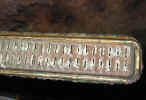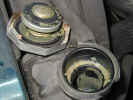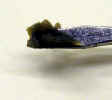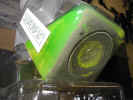Non-Toyota Coolant opinions...Zerex? Pentofrost? Peak Global?
#1
Registered User
Thread Starter
Join Date: Aug 2012
Location: West Virginia
Posts: 22
Likes: 0
Received 0 Likes
on
0 Posts
Non-Toyota Coolant opinions...Zerex? Pentofrost? Peak Global?
Alright....there seem to be so many opinions out there and it's making my brain hurt to understand the science of antifreeze varieties, what do folks on here use/think?
I'm out in the sticks away from a toyota dealership, and would rather use something that I could at least order at a NAPA. It seems like
Zerex Asian=Pentofrost A1=Toyota Red, they are essentially all silicate-free, high phosphate and the good stuff for long intervals between changes.
I see some folks use Peak Global, which I think is also silicate-free, and ought to be much more easy to find, but I'm skeptical now of all 'universal' coolants.
I just opened up my overflow and I had about 4 inches of gunk collected. for the last three years I've been running the same green stuff and think it's time to go for something better.
I'm thinking about going with the Zerex since it's the cheapest of the three red options.
I'm out in the sticks away from a toyota dealership, and would rather use something that I could at least order at a NAPA. It seems like
Zerex Asian=Pentofrost A1=Toyota Red, they are essentially all silicate-free, high phosphate and the good stuff for long intervals between changes.
I see some folks use Peak Global, which I think is also silicate-free, and ought to be much more easy to find, but I'm skeptical now of all 'universal' coolants.
I just opened up my overflow and I had about 4 inches of gunk collected. for the last three years I've been running the same green stuff and think it's time to go for something better.
I'm thinking about going with the Zerex since it's the cheapest of the three red options.
#2
Registered User
I know how you feel, I live along way from toyota red and a dealership also. Ive been running green for years and have had no issues with it. I used to change it and flush every two years, but I dont drive my Toyota that much anymore, so I usually go 3 yrs. Some will tell you to use nothing but red, but thats not much of an option for me unless I have it shipped and like I say Ive had good luck with green.
#3
Registered User
My 88 came from the factory filled with green coolant. I have always used green Prestone coolant. Never had a single problem.
Where people get into problems with coolant is when they leave it in there for years and it turns acidic. If you change out the coolant every two to three years like it's designed to, you’re fine.
When I rebuilt the engine in my 22re, my block had no rust or metal deforming due to electrolysis. I attribute this to changing the coolant every two years. Preventative maintenance is more practicable than finding the correct coolant and never changing it...just saying.
Where people get into problems with coolant is when they leave it in there for years and it turns acidic. If you change out the coolant every two to three years like it's designed to, you’re fine.
When I rebuilt the engine in my 22re, my block had no rust or metal deforming due to electrolysis. I attribute this to changing the coolant every two years. Preventative maintenance is more practicable than finding the correct coolant and never changing it...just saying.
#4
It's not all exactly the same. But it all works the same...for the most part.
I recently switched from the standard green stuff to PEAK® GLOBAL LifeTime™ because:
a. It's relatively cheap(in comparison to OEM or waterless)
b. It should last longer(than any current non waterless types of coolant on the market, including OEM)
c. If I'm going to use an OAT coolant in my Toyota, I want to use one that's a silicate-free and non 2-EHA formula, if available. It's also phosphate-free for the record.
Here's an interesting read on coolant types(though it's a little out of date):
http://sancarlosradiator.com/antifreeze_coolant.htm
I recently switched from the standard green stuff to PEAK® GLOBAL LifeTime™ because:
a. It's relatively cheap(in comparison to OEM or waterless)
b. It should last longer(than any current non waterless types of coolant on the market, including OEM)
c. If I'm going to use an OAT coolant in my Toyota, I want to use one that's a silicate-free and non 2-EHA formula, if available. It's also phosphate-free for the record.
Here's an interesting read on coolant types(though it's a little out of date):
http://sancarlosradiator.com/antifreeze_coolant.htm
Last edited by MudHippy; 08-24-2012 at 10:28 AM.
#5
Registered User
iTrader: (1)
On my older engines I run whatever flavor the local auto parts is selling that week. It gets changed so often any long life antifreeze is a moot point.:jessica:
Buy a case or two I am good to go. for a month or 2
For my Newer 3.4 I run The Toyota red. Every once in a while I pick up another case.
I can understand about being in WVA .
Buy a case or two I am good to go. for a month or 2
For my Newer 3.4 I run The Toyota red. Every once in a while I pick up another case.
I can understand about being in WVA .
#7
I run the Red. It was in my truck at 150k when I bought it and with 253k on the clock I have not had any issues to date. It is pretty easy to get around here and I keep a few Jugs on hand just in case. I only changed it when I pulled the heads within 3k miles. So 100k miles in ~2 years and the Coolant still looked great.
I really don't see any reason you would HAVE to use it though. It isn't like the Block or any peripherals are a special metal. If you change it up often there is no reason I could see that you would have to use the Red.
I really don't see any reason you would HAVE to use it though. It isn't like the Block or any peripherals are a special metal. If you change it up often there is no reason I could see that you would have to use the Red.
Last edited by rockchucker; 08-24-2012 at 03:27 PM.
Trending Topics
#8
Registered User
They started using different colors when rads went aluminum some of the antifreeze companys had corrosive chemicals against aluminum that's why now a days there is so many universal dyes
#9
See quoted post below. Which was originally intended as a reply to the statement quoted above.
Last edited by MudHippy; 08-25-2012 at 04:22 PM.
#10
Registered User
Not so. Think about it. Aluminum heads have been commonplace on engines for probably longer than you've been alive(longer than I have atleast, and I'll be 37 in about a month). And fancy colored(not green) anti-freeze didn't show up until the mid-90's. So what kind of sense does that make? Don't answer that...please(just a rhetorical). In fact, the newer non green/silicate-free or low silicate anti-freezes offer LESS immediate protection for aluminum engine parts(including radiators). Which is part of the debate on whether or not to use ANY non green/silicate-free or low silicate coolants in engines that have aluminum components in contact with the anti-freeze/coolant. In short, silicates provide immediate protection to aluminum, where as coolants that don't have any(or very little) silicates have to be used for a period of time before establishing a protective coating/layer on aluminum surfaces. Only after which do they become effective in protecting aluminum.
Since you obviously didn't check the link I provided, which explains when and why the changes were actually made, let me quote it for you.
COOLANT, CHEMISTRY, AND CORROSION

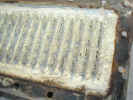
Silicates are deemed to be abrasive in a cooling system, and are blamed for premature water pump seal failure. With the average miles per year per car on the rise, it does seem to be a valid concern. But is it worth the price of a dex-cool clean up? If your water pump is timing belt driven, the water pump may be replaced at 60,000 or 90,000 miles anyway.
Organic Acid Technology or OAT's are coolants that are formulated without the use of silicates. Since silicates have a short life, removing them allows a longer service life. Typically, coolants advertised as 5 year, long life , extended life or Dex-cool are examples of OAT's. Common components to OAT coolants are Carboxylate, sebacate, and 2-ethylhexanoic acid (2-EHA), which are corrosion inhibitors, used instead of silicates. Depending on which manufacturer is filling the jug, the inhibitors may change. Dex-cool uses 2-EHA which among other things is a plasticizer which has the effect of softening plastic. GM intake manifolds are made of plastic........... If it is found that Dex-cool is dissolving the gasket material, it will validate what some folks have been saying for a long time: Dex-cool eats gaskets. We'll see. Prestone doesn't use 2-EHA in it's long life coolant, instead uses carboxylate.
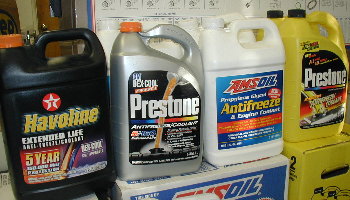 As long as the cooling system is in good shape and the chemistry is balanced, these coolants have demonstrated that in fact they can go longer that their predecessors. However, when the balance is upset, either by improper filling procedures or weak concentrations or improper manufacturing, the OAT can come apart, causing thousands of dollars in repair bills. GM's Dex-cool is a huge problem on some vehicles. Class action suit pending.....
As long as the cooling system is in good shape and the chemistry is balanced, these coolants have demonstrated that in fact they can go longer that their predecessors. However, when the balance is upset, either by improper filling procedures or weak concentrations or improper manufacturing, the OAT can come apart, causing thousands of dollars in repair bills. GM's Dex-cool is a huge problem on some vehicles. Class action suit pending.....
Since you obviously didn't check the link I provided, which explains when and why the changes were actually made, let me quote it for you.
COOLANT, CHEMISTRY, AND CORROSION
- Water
- Ethylene Glycol
- Silicates
- Organic Acid Technology
- Propylene Glycol
- Waterless Coolants
- Coolant Additives
- First, it has a tendency to freeze at 0C` (32F`). Not considered a desired trait since during freezing, expansion occurs and thick metal castings can be rendered useless. If this does occur, hopefully the freeze plugs allow enough expansion relief.
- Second, water will boil at 100C` (212F`). This is definitely not desired. As the water boils, interruption to coolant flow occurs, the steam vapor displaces the liquid capacity, further reducing efficiency.
- Third, plain water will allow corrosion to occur on dissimilar metals, and deterioration to accelerate. The best way to insure your self of expensive cooling system repairs is to fill with plain water only!

The 3 Main Formulations of ethylene glycol coolant exist are: 1) Silicate based also known as green coolant, 2) Organic Acid Technology based commonly called OAT's, which include extended life or Dex-cool, and 3) Hybrid coolants, which is a combination of organic acid technology mixed with a low dose of silicates. Many so-called "universal coolants" are members of the hybrid family.
Green Coolant is almost a thing of the past on newer cars. What's wrong with green coolant? Well, in a word, nothing! Traditional green coolant is mostly ethylene glycol, silicates, and green dye. Newer coolants have basically the same ingredients, but with orange, red, blue, purple or amber coloring, and without the high level of silicates. Why is the trend moving away from green antifreeze? Longer maintenance cycles. These days we want every thing to last longer.
Silicates are a chemical compound containing silicon, oxygen, and one or more metals, e.g., aluminum, barium, beryllium, borate, calcium, iron, magnesium, manganese, molybdate, nitrite, nitrate, phosphate, potassium, sodium, or zirconium. Silicates may be considered chemically as salts of the various silicic acids. 1 In a cooling system, silicates offer metal parts ( especially aluminum ) a high level of fast acting protection against corrosion and pitting that is vital. Silicates "charge up" a cooling system with protection that lasts about 2 years. After two years, the coolant mix needs to be replaced with new coolant and water. New every two.
Silicates offer instant protection to the cooling system. Heavy duty vehicles rely on silicates to give precise amounts of protection, and can be recharged without draining the entire coolant. Silicates do have a life, and it's a short one - two years. If left longer, build up inside the radiator begins, and the silicates actually contribute to cooling system problems. Silicate drop out occurs after the coolant has been "spent", and the inhibitors drop out of solution. Silicates are blamed for deposit build up in radiators and heaters, causing engine overheating and poor heater performance. Once the silicates drop out of solution, dissimilar metal corrosion is no longer suppressed, and metal components begin to deteriorate.

Silicate
Silicates are deemed to be abrasive in a cooling system, and are blamed for premature water pump seal failure. With the average miles per year per car on the rise, it does seem to be a valid concern. But is it worth the price of a dex-cool clean up? If your water pump is timing belt driven, the water pump may be replaced at 60,000 or 90,000 miles anyway.
Organic Acid Technology or OAT's are coolants that are formulated without the use of silicates. Since silicates have a short life, removing them allows a longer service life. Typically, coolants advertised as 5 year, long life , extended life or Dex-cool are examples of OAT's. Common components to OAT coolants are Carboxylate, sebacate, and 2-ethylhexanoic acid (2-EHA), which are corrosion inhibitors, used instead of silicates. Depending on which manufacturer is filling the jug, the inhibitors may change. Dex-cool uses 2-EHA which among other things is a plasticizer which has the effect of softening plastic. GM intake manifolds are made of plastic........... If it is found that Dex-cool is dissolving the gasket material, it will validate what some folks have been saying for a long time: Dex-cool eats gaskets. We'll see. Prestone doesn't use 2-EHA in it's long life coolant, instead uses carboxylate.

Hybrid Coolants, also known as HOAT's or G-O5 is a OAT coolant with a low silicate charge added. The idea is to reap the benefits of longer life OAT while retaining the positive characteristics of silicates. In areas where hard water deposits have been a problem, the HOAT blend holds up very well. The main inhibitor in popular HOAT's is Benzoate
Most GM cars changed from green coolant to Dex-cool in 1996, while Chrysler went from green to HOAT in 2002. Ford changed to HOAT in 2003. The European vehicles have never been a fan of traditional green, and have been using HOAT or OAT right along. The Asian vehicles switched from HOAT to OAT in 1996. The trend is clear, silicate levels are dropping, and as OAT inhibitors get better, soon silicates may be a thing of the past. Thanks to Zerex, a colorful chart is available to pinpoint coolant types for various vehicles.
Propylene Glycol A colorless viscous hygroscopic liquid, CH3CHOHCH2OH, used in antifreeze solutions, in hydraulic fluids, and as a solvent.1 Although the thermal properties of PG (propylene glycol) are less desirable that EG (ethylene glycol), there is one main advantage- it is not toxic to humans and animals. While EG is sweet to the taste and animals are attracted to it by curiosity and smell. Because of it's taste and toxicity, EG is responsible for many pet deaths per year. PG may be the logical choice if garage space is shared with a pet. Recent formulations of PG include a low silicate OAT with purported 7 year 70000 mile life. We'll see about that.
Waterless Coolants Not enough is know (by me) about waterless coolants to be able to comment on them. However, the idea is this: if we can get rid of the limiting properties of water e.g.: boils at 100C`, freezes at 0C`, allows corrosion, conducts electricity & allows electrolysis to occur, while increasing the thermal absorption of the coolant, ...viola`! We'll see.
Coolant Additives are not coolants themselves, and must be used cautiously. They change the chemistry and properties of the coolants so that desired "behaviors" are achieved. The biggest sought after behavior is the reduction of surface tension. Other goals include pH reagents, electrolysis suppressors, water soluble oils, increased alkalinity reserves, the list goes on and on. While very useful in treating a specific conditions, it is not recommended that a person put one of everything in a cooling system. Not only would the coolant be diluted, but the chemistry might be quite interesting!
Which coolant is right for my car? Green? Orange? Blue? The folks a Zerex have manufactured 3 coolant to address the 3 main type s of EG coolant, and have generously supplied a colorful chart to help answer questions as to proper coolant selection.
#11
Try this link , or try using the links to the chart found here. I couldn't attach it to this post, because the file's too large.
I'll go ahead and delete the portion of my post that you've quoted. Since there's no need for a repeat of its entirety. Makes the thread a little harder to navigate and/or read when extremely large posts are quoted as a whole like that. Just don't go messing with the quote now. Or things won't make sense. Please leave it as is, if you'd be so kind. Thanks.
There's more than one way to skin a cat.
Last edited by MudHippy; 08-25-2012 at 04:21 PM.
#12
I have a 90 truck that has always been cooled with Toyota Red. I replaced the water pump in conjunction with the timing belt and the original pump looked new. From what I could see of the block interior, thermostat etc, all looked fine. I do agree the best preventive maintenance is change coolant at minimum OEM recommendations. My Ford, Chevy, and Nissan all have the Prestone Long-Life. So far so good. Lord willing, eventually all my transportation will be Toyota powered.
#13
Wrong!
Maybe since you've owned it. But Toyota didn't begin filling their engines with red/pink coolant until 96. Let me quote some FSMs to prove my point.
From the 95 FSM, 3VZ-E cooling system; coolant replacement pages:
From the 95.5 FSM, 5VZ-FE cooling system; coolant replacement pages:
From the 96 FSM, 5VZ-FE cooling system; coolant replacement pages:
FILL ENGINE COOLANT
(a) Slowly fill the system with engine coolant.
Use of improper coolants may damage engine cooling system.
Use ”TOYOTA Long Life Coolant” or equivalent and mix it with plain water according to the manufacturer’s directions.
Use of the coolant which includes more than 50% (freezing protection down to -35°C (-31 °F)) or
60% (freezing protection down to -50 °C (-58 °F)) of ethylene-glycol is recommended, but not more than 70%
NOTICE:
Do not use an alcohol type engine coolant.
The engine coolant should be mixed with demineralized water or distilled water.
Maybe since you've owned it. But Toyota didn't begin filling their engines with red/pink coolant until 96. Let me quote some FSMs to prove my point.
From the 95 FSM, 3VZ-E cooling system; coolant replacement pages:
FILL ENGINE COOLANT
(a) Slowly fill the system with engine coolant.
Use a good brand of ethylene – glycol base engine
coolant and mix it according to the manufacturer’s
directions.
Using engine coolant which includes more than
50 % ethylene–glycol (but not more than 70 %)
is recommended.
NOTICE:
Do not use an alcohol type engine coolant.
The engine coolant should be mixed with demineralized water or distilled water.
(a) Slowly fill the system with engine coolant.
Use a good brand of ethylene – glycol base engine
coolant and mix it according to the manufacturer’s
directions.
Using engine coolant which includes more than
50 % ethylene–glycol (but not more than 70 %)
is recommended.
NOTICE:
Do not use an alcohol type engine coolant.
The engine coolant should be mixed with demineralized water or distilled water.
From the 95.5 FSM, 5VZ-FE cooling system; coolant replacement pages:
FILL ENGINE COOLANT
(a) Slowly fill the system with engine coolant.
• Use a good brand of ethylene - glycol base
engine coolant and mix it according to the
manufacturer's directions.
• Using engine coolant which includes more than 50
% ethylene-glycol (but not more than 70 %) is recommended.
NOTICE:
• Do not use an alcohol type engine coolant.
• The engine coolant should be mixed with demineralized water or distilled water.
(a) Slowly fill the system with engine coolant.
• Use a good brand of ethylene - glycol base
engine coolant and mix it according to the
manufacturer's directions.
• Using engine coolant which includes more than 50
% ethylene-glycol (but not more than 70 %) is recommended.
NOTICE:
• Do not use an alcohol type engine coolant.
• The engine coolant should be mixed with demineralized water or distilled water.
From the 96 FSM, 5VZ-FE cooling system; coolant replacement pages:
FILL ENGINE COOLANT
(a) Slowly fill the system with engine coolant.
Use of improper coolants may damage engine cooling system.
Use ”TOYOTA Long Life Coolant” or equivalent and mix it with plain water according to the manufacturer’s directions.
Use of the coolant which includes more than 50% (freezing protection down to -35°C (-31 °F)) or
60% (freezing protection down to -50 °C (-58 °F)) of ethylene-glycol is recommended, but not more than 70%
NOTICE:
Do not use an alcohol type engine coolant.
The engine coolant should be mixed with demineralized water or distilled water.
Last edited by MudHippy; 08-26-2012 at 07:50 AM.
Thread
Thread Starter
Forum
Replies
Last Post
LittleUgly
86-95 Trucks & 4Runners (Build-Up Section)
15
01-02-2020 01:30 PM
kcaudill
86-95 Trucks & 4Runners
19
10-10-2015 02:39 PM
acid, cars, coolant, corrosion, ethylhexanoic, global, gm, hoat, ingredients, inhibitor, peak, pentafrost, radiator, switching, toyota


